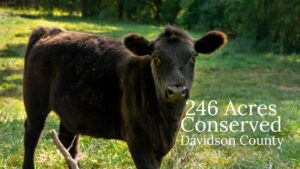
by Crystal Cockman
February 10, 2016
In a book called Feral by George Monbiot, he spends some time dealing with a species some consider a nuisance here in the United States – beavers. Beavers were hunted to extinction in Britain for their fur and for castoreum, a secretion from glands near the tail used for making perfumes and medicine. Their reintroduction there has been controversial, as some fisherman mistakenly think they will eat their fish. Beavers are actually herbivores, but they can indeed have a huge impact on their local environment.
Monbiot makes the point that beavers are a keystone species – meaning that their presence makes it possible for other species to live in the ecosystem. In the United States, one can easily see the impact beavers make in building large dams that result in beaver ponds – habitat for a great variety of other species, such as muskrat, frogs, and ducks. In Britain the beavers built only small dams, but still affected river hydrology and created habitat for a number of other species.
Monbiot deals with the idea of rewildling, or reintroducing species that once would have existed in order to restore diversity to an ecosystem. Beavers are one such species, but another one he mentions is the reintroduction of wolves to Yellowstone National Park. The wolves clearly had an impact on the deer population, but what was less immediately apparent was that their effects went far beyond just deer. The deer ate trees right up to riverbanks before the wolves were introduced, but soon grew to avoid those areas where they might be caught most easily. The trees grew back quickly, and cooled streams and provided habitat for fish and other wildlife.
Stable streamsides also changed hydrology and improved water quality. Monbiot goes on to explain how the wolves impacts carry down the food chain, such as by eating coyotes they allow smaller animals like rabbits to rebound, and this in turn provides food for other animals like hawks. The complex interweaving of this web of life could not be better demonstrated, and few of us would think about all these secondary effects of the reintroduction of wolves. He suggests that food webs are more affected by the loss of top predators than anything else.
But back to beavers. In North America, beavers once numbered greater than 60 million, but now number around 10 million. This decline is for the same reasons stated above that led to the extinction of the beaver in Great Britain. One additional reason why beavers are killed is to prevent their alteration of the landscape that interferes with other land uses. They have been in North America for a long time, and there historically was even a giant beaver, now extinct, that weighed as much as 300 pounds and was larger than 7 feet in size. Imagine the impacts that creature could have on a landscape.
Beavers are best known for building lodges and dams on rivers and streams, and it is almost impossible to remove a beaver dam without removing the beavers, as they are known to rebuild these as quickly as overnight. Beaver ponds and wetlands, in addition to providing habitat for a variety of other wildlife, are also useful in filtering pollutants. Although they can certainly be considered a pest when they flood agricultural fields and other areas, if their wetlands are not damaging anything leaving the beavers alone is preferable. This habitat can provide an interesting landscape of wildlife to watch and enjoy.